tow CADILLAC DEVILLE 1995 7.G User Guide
[x] Cancel search | Manufacturer: CADILLAC, Model Year: 1995, Model line: DEVILLE, Model: CADILLAC DEVILLE 1995 7.GPages: 403, PDF Size: 20.69 MB
Page 229 of 403

Downloaded from www.Manualslib.com manuals search engine You can ask a hitch dealer about sway controls.
Don’t tow a trailer at all during the first 1,000 miles ( 1 600 krn) your new
vehicle
is driven. Your engine, axle or other parts could be damaged.
0 Then, during the first 500 miles (800 km) that you tow a trailcr, don’t
drive over
50 mph (80 km/h) and don’t make starts at full throttle. This
helps
your engine and other parts of your vehicle wear in at the
heavier loads.
Obey speed limit restrictions when towing a trailer. Don’t drive faster
than the maximum posted speed
for trailers (or no more than 55 mph
(90 kndh)) to save wear on your vehicle’s parts.
Three important considerations
have to do with weight:
Weight of the Trailer
How heavy can a trailer safely bc?
It should never weigh more than 1.000 pounds (450 kg) total, including
the load.
But even that can be too hcavy.
c
It depends 011 how you plan to use your rig. For example, speed, altitude,
road grades, outsidc tcmperature and how mrrch your vehicle is used to
pull a trailer are all important. And, it can also depend on any spccial
equipment that you have on your vehicle.
In Canada, write to General Motors of Canada Limited, Cilstomer
Assistance Center,
1908 Colonel Sam Drive. Ochawa, Ontario LlH SP7.
Weight of the frailer Tongue
The tongue load (A) of any trailer is an important weight to measure
because it affects the total capacity weight of your vehiclc. The capacity
weight
includes the curb weight of the vehicle, any cargo you may carry in
it, and the people who will be riding it1 the vehicle. And if you will tow a
trailer: you must subtract the tongue load from your vehicle‘s capacity
weight because your vehicle
will be carrying that weight, too. See
“Loading Your Vehicle”
in the Index for more information about your
vehicle’s maximum load capacity.
4-36
Page 232 of 403
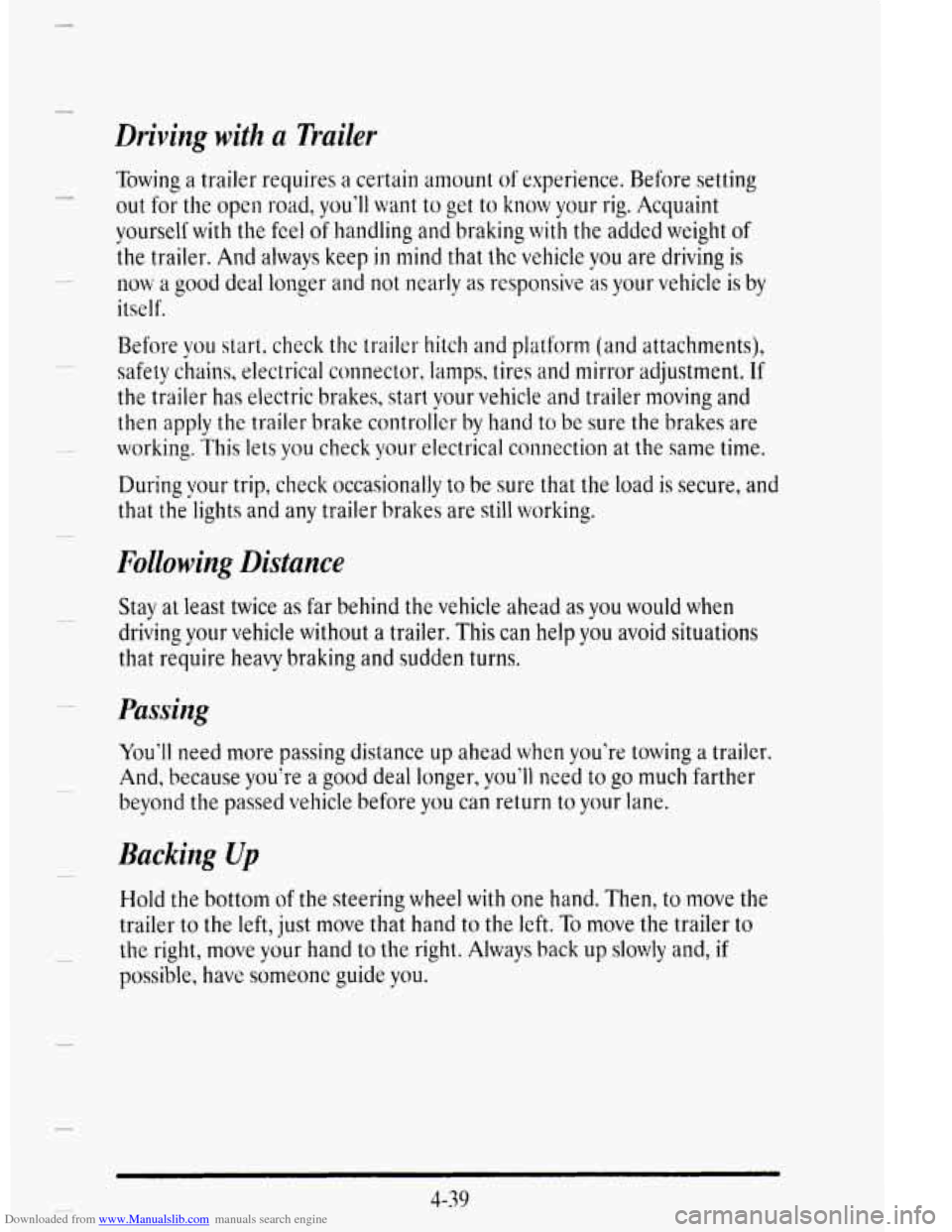
Downloaded from www.Manualslib.com manuals search engine Driving with a Trailer
Towing a trailer requires a certain amount of experience. Before setting
out for the open road, you’ll want to get to know your rig. Acquaint
yourself
with the feel of Ilandling and braking with the added weight of
the trailer. And always keep in mind that thc vehicle you are driving is
now a good deal longer and not nearly as responsivs as your vehicle is by
itself.
Before you start, check thc trailer hitch
and platform (and attachments),
safety chains, electrical connector, lamps, tires
and mirror adjustment. If
the trailer has electric brakes, start your vehicle and trailer moving and
then apply the trailer brake controlier by hand
to be sure the brakes are
working.
This lets you check your electrical connection at the same time.
During \Tour trip, check occasionally to
be sure that the load is secure, and
that the’lights and any trailer brakes are still working.
Following Distance
Stay at least twice as far behind the vehicle ahead as you would when
driving your vehicle without a trailer. This can help
you avoid situations
that require heavy braking and sudden turns.
Passing
You’ll need more passing distance up ahead when you’re towing a trailer.
And, because you‘re a good deal longer,
you’ll need to go much farther
beyond
the passed vehicle before you can return to your lane.
Bucking Up
Hold the bottom of the steering wheel with one hand. Then, to move the
trailer
to the left, just move that hand to the left. To move the trailer to
the right, move your hand to the right. Always back up slowly and, if
possible, havc someone guide you.
4-39
Page 233 of 403
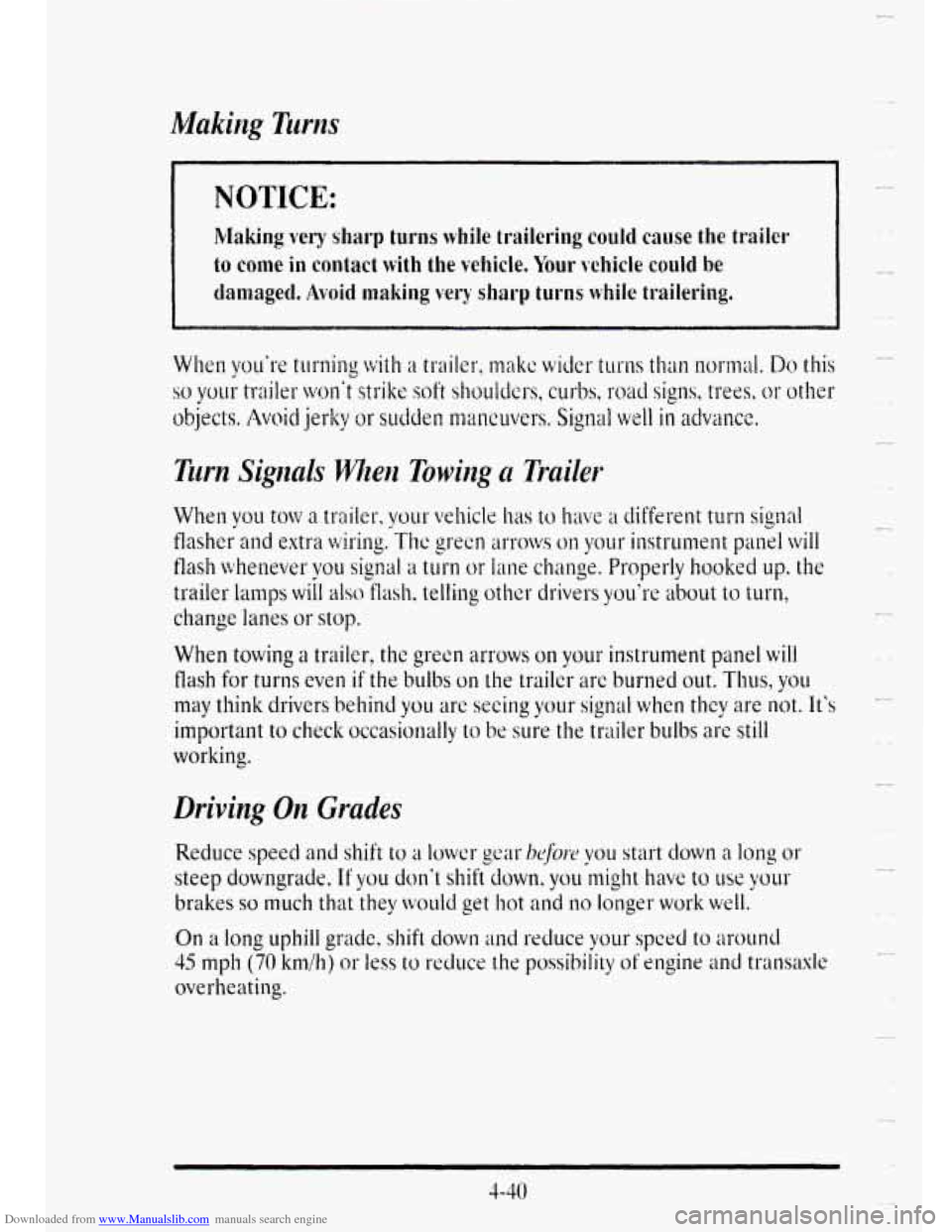
Downloaded from www.Manualslib.com manuals search engine NOTICE:
Making very sharp turns while trailering coulcl cause the trailer
to come in contact with the vehicle. Your whicle could be
damagecl. Avoid making very sharp turns while trailering.
When towing a trailer? the green arrows on your instrument panel will
flash for turns even if the bulbs on the trailcr are burned out. Th, you
may think drivers behind you are seeing your signal when they are not. It's
important to check occasionally to be sure the trailer bulbs are still
working.
Driving On Grades
Reduce speed and shift to a lowcr gear bcfow VOLI start clown a long or
steep downgrade. If you don't shift down. youkight have to use your
brakes so much that they would get hot and no longer work well.
On a long uphill grade. shift down ;1nd reduce your speed to u-ound
45 mph (70 km/h) or less to reduce the possibility of engine and transaxle
overheating.
4-4:)
c-
c
.c
Page 234 of 403
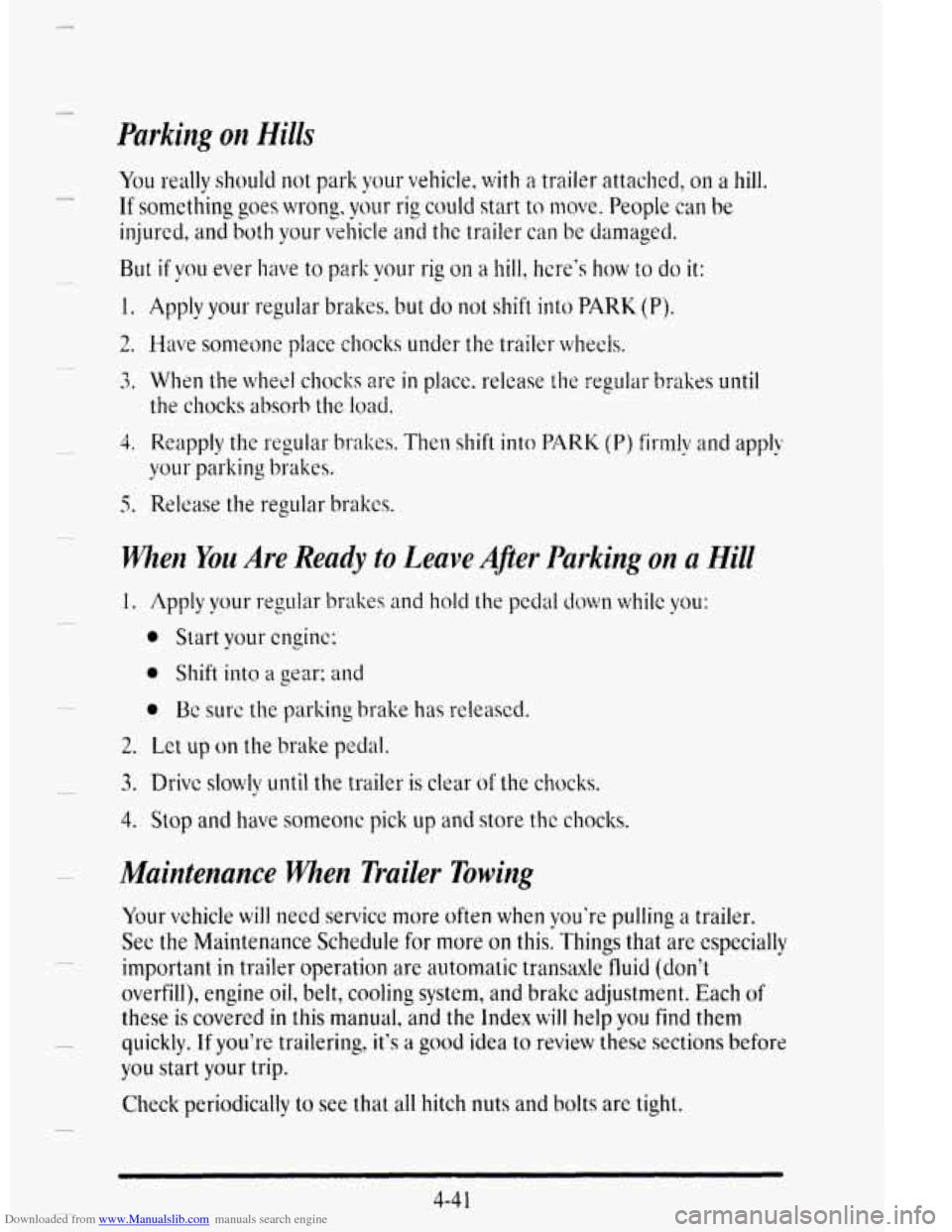
Downloaded from www.Manualslib.com manuals search engine Parking on Hills
You really should not park your vehicle, with a trailer attached, on a hill.
If something goes wrong, y&r riq could start to move. People can be
injured, and
both your vel;icle and the trailer can be darnagecl.
L.
But if you ever have to park your rig on a hill, here‘s how to do it:
1. Apply your regular brakes, but do not shift into PARK (P).
2. ILiave sonleone place chocks under the trailer whecls.
Wzen You Are Ready to Leave A@r Parking on n Hill
3
2. Let up on the brake pedal.
3. Drivc slowly until the trailer is clear of the chocks.
4. Stop and have someone pick up and store the chocks.
Maintenance when Trailer Towing
Your vehicle will need service more often when you’re pulling a trailer.
See the Maintenance Schedule for more on this. Things that are especially
important
in trailer operation are automatic transaxle fluid (don’t
overfill), engine
oil, belt, cooling system, and brake adjustment. Each of
these is covered in this manual, and the Index will help you find them
quickly.
If you’re trailering, it’s a good idea to review these sections before
you start your trip.
Check periodically
to see that all hitch nuts and bolts are tight.
4-4 1
Page 244 of 403

Downloaded from www.Manualslib.com manuals search engine TOWING YOUR VEHICLE
Ti-y to have a GM dealer or a professional towmg service tow your
Cadillac. The usual towing equipment is :
Sling Type
0 Wheel Lift
8 Car Carrier
If your vehicle has been changed or modified since it was factory-new by
adding aftermarket items like fog lamps, aero skirting or speciai tires and
wheels, these instructions and illustrations
may not be correct.
Before
you do anything, turn on the hazard warning flashers.
When you call, tell the towing service:
That your vehicle cannot be towed from the front or rear with
That your vehicle has front-wheel drive.
sling-type
equipment.
8 The makc, model and year of your whicie.
Whether you can still move the shift lever.
0 If thcre was an accident., wha1 was damaged.
Page 245 of 403

Downloaded from www.Manualslib.com manuals search engine When the towing service arrives, let the tow operator know that this
manual contains detailed
towing instructions and illustrations. The
operator may want to see them.
..
. , . . , , . .....................
........ ..
..
.....
..
5- 10
Page 246 of 403
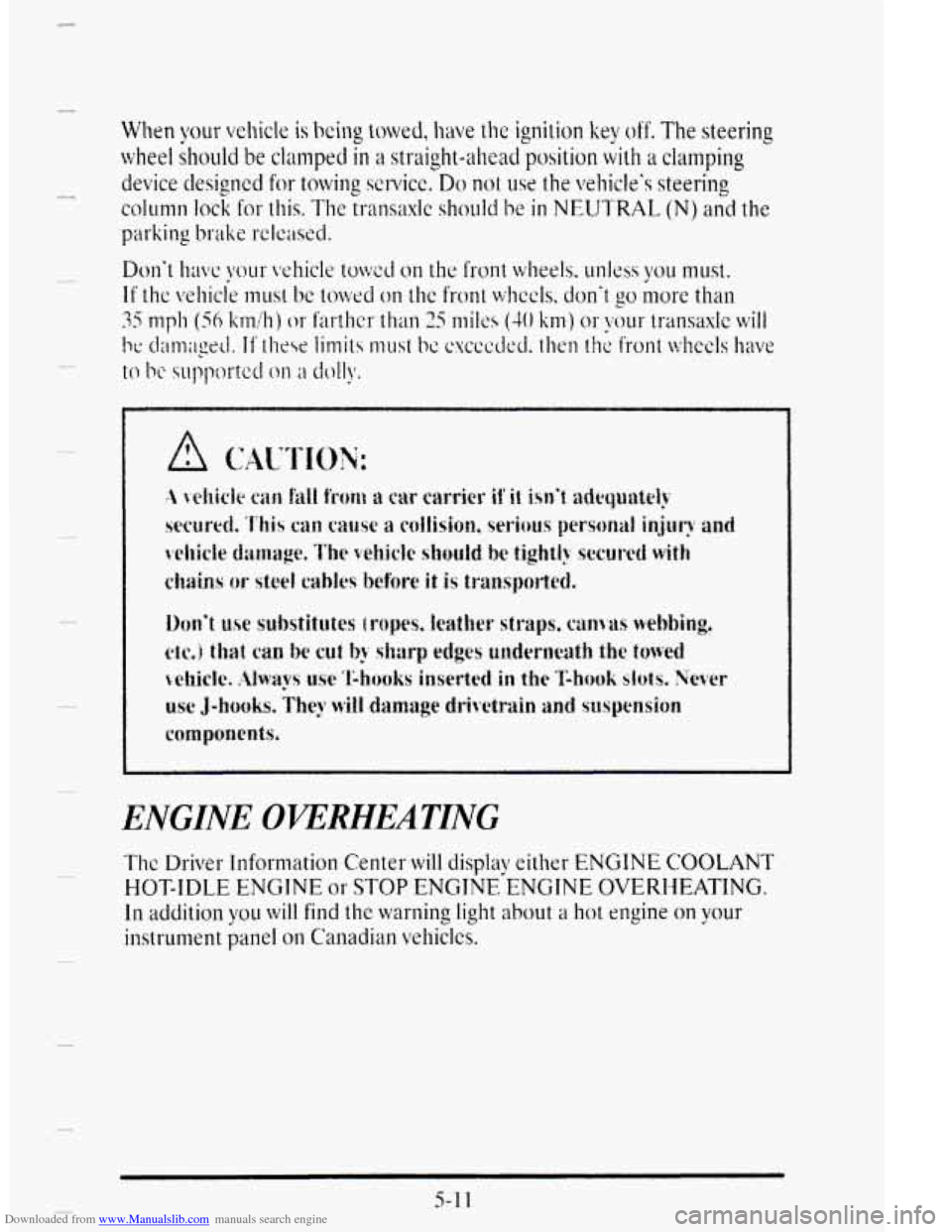
Downloaded from www.Manualslib.com manuals search engine When your vehicle is being towed, have the ignition key off. The steering
wheel should be clamped in a straight-ahead position with a clamping
device designed for towing selvicc. Do not use the whicle's steering
colunln lock for this. The trallsaxlc should he in NEUTRAL (N) and the
parking hrake relc;lsd.
ENGINE OVERHEATING
c
TIIC Driver Information Center will displav either ENGINE COOL.ANT
HOT-IDLE ENGINE 01 STOP ENGINEdENGINE OVERHEATING.
In addition you will find the warning light about a hot engine on your
instrument panel on Canadian vehiclcs.
Page 248 of 403

Downloaded from www.Manualslib.com manuals search engine IfNo Steam Is Coming From Your Engine
If you get the overheat warning but see or hear no steam, the problem
may not be
too serious. Sonletimes the engine can get a little too hot
when you:
Climb a long hill on a hot day.
Stop after high speed driving.
Idle for long periods in traffic.
0 Tow a trailer.
If you get the overheat warning with no sign of steam,
or so:
1. Turn off your air conditioner.
try this for a minute
2. Dial temperature control to the highest heat setting and open the
3. If you’re in a traffic jam, shift to NEUTRAL (N); otherwise, shift to
window, as necessary.
thi highest gear while driving -- AUTOMATIC OVERDRIVE (0) or
THIRD (3).
If you no longer have the overheat warning, you can drive. Just to be safe,
drive slower for about
10 minutes. If the warning doesn’t come back on,
you can drive normally.
If the warning continues, pull over, stop, and park your vehicle right away.
If there’s still no sign
of steam, you can idle the engine for two or three
minutes
while you‘re parked, to see if the warning stops. But then, if you
still have the warning, turx off the cwgillc alzdgct c‘wyouc out of [he vehicle
until it cools down.
You may decide not to lift the hood but to get service help right away.
5-1 3
Page 269 of 403

Downloaded from www.Manualslib.com manuals search engine IF Y0UX.E STUCK: IN SAND, MUD, ICE OR
SNOW
What you don't want to do when your vehicle is stuck is to spin your
wheels too fast. The method known as .*rocking" can help you get out
when you're stuck, but you must use caution.
u
NOTICE:
Spinning your wheels can destroy parts of your vehicle as well
as the tires. If you spin the wheels too Fast while shifting your
transaxle back and forth, you can destroy your transaxle.
For information about using tire chains on your vehicle, see "Tire Chains"
in the Index.
Rocking your vehicle to get it out:
First, turn your steering wheel left and right. That will clear the area
around your
front wheels. You should turn your traction control system
off. (See "Traction Control System" in the Index.) Then shift back and
forth between REVERSE (R) and a forward gear, spinning the wheels as
little as possible. Release the accelerator pedal while you shift, and press
lightly on the accelerator pedal when the transaxle is in gear. if that
doesn't get you out after a few tries, you may need to be towed out. If you
do need to be towed aut, see '*Towing Your Vehicle" in the Index.
5-34
-.
Page 279 of 403
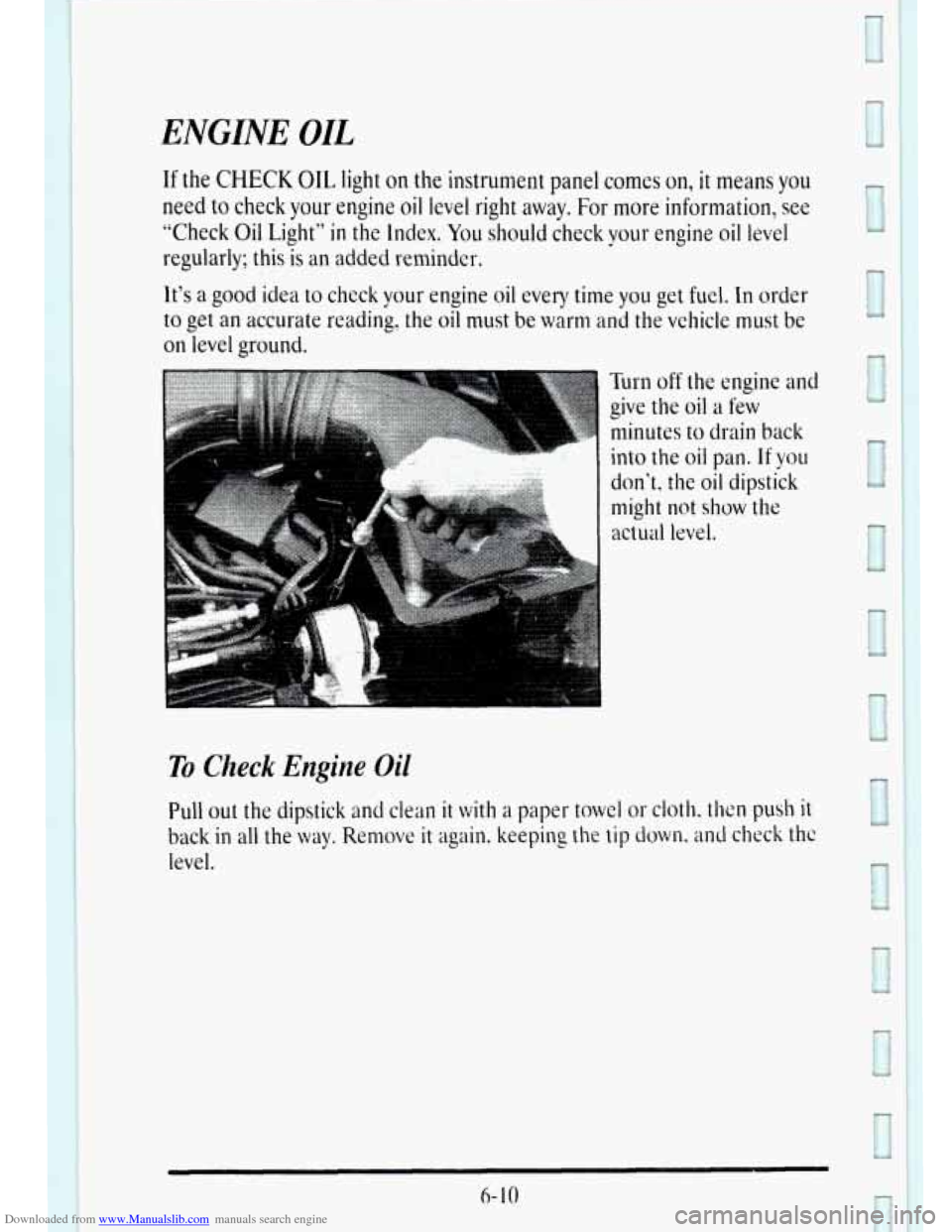
Downloaded from www.Manualslib.com manuals search engine ENGINE OIL
If the CHECK OIL light on the instrument panel comes on, it means you
need to check your engine oil level right away. For more information, see
“Check
Oil Light” in the Index. You should check your engine oil level
regularly;
this is an added reminder.
It’s a good idea
to check your engine oil every time you get fuel. In order
to get an accurate reading,
the oil must be warm and the vehicle must be
on level ground.
Turn off the engine and
give
the oil a few
minutes
to drain back
into
the oil pan. If you
don‘t, the
oil dipstick
might
not show the
actual level.
. . . . ... . X..
t
Tu Check Engine Oil
I
0
Puli out the dipstick and clean it with a paper towel or cloth, then push it
back in all the way. Remove it again, keeping the tip down, and check thc
level.
c
6- 10